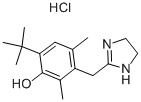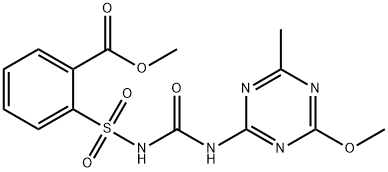Amprolium
Synonym(s):1-([4-Amino-2-propyl-5-pyrimidinyl]methyl)-2-methylpyridinium chloride;Amprolium;Amprolium hydrochloride
- CAS NO.:121-25-5
- Empirical Formula: C14H19N4.Cl
- Molecular Weight: 278.79
- MDL number: MFCD00072061
- EINECS: 204-458-4
- SAFETY DATA SHEET (SDS)
- Update Date: 2025-02-26 11:47:18

What is Amprolium?
Description
Amprolium is an antiprotozoal agent used for the prevention of coccidiosis in poultry.
Chemical properties
solid
Originator
Neoprol ,SIMB
The Uses of Amprolium
Coccidiostat (for poultry).
The Uses of Amprolium
Amprolium is an oral coccidiostat, a thiamine analogue, which is used for the prevention and treatment of intestinal coccidiosis . It is used as a feed additive for livestock, sometimes administered in the food or drinking water of puppies and kittens, and in chickens and calves.
Definition
ChEBI: An organic chloride salt having 1-[(4-amino-2-propylpyrimidin-5-yl)methyl]-2-methylpyridin-1-ium as the counterion. Used for prevention of coccidiosis in poultry and cattle.
Manufacturing Process
1.9 grams of p-toluene sulfonyl chloride was added gradually with shaking to a cooled (0-5°C) solution of 1.67 grams of 2-n-propyl-4-amino-5-hydroxymethyl pyrimidine in 10 ml of 2-methylpyridine. The reaction mixture, after standing three hours in an ice bath, and 15 hours at room temperature, was evaporated to dryness in vacuo. The residue was dissolved in 20 ml of water, acidified with hydrochloric acid and poured over a column of Amberlite IRA- 400 ion exchange resin on the chloride cycle. The eluate was evaporated to dryness to give a residue of 1-(2-n-propyl-4-amino-5-pyrimidylmethyl)-2- methyl pyridinium chloride hydrochloride. On recrystallization from a methanol-ethanol mixture, the quaternary had melting point 246°C (dec.).
brand name
Amprol [Veterinary] (Merial); Amprovine [Veterinary] (Merial); Corid [Veterinary] (Merial).
Therapeutic Function
Coccidiostatic
Contact allergens
Amprolium is an antiprotozoal agent used for the prevention of coccidiosis in poultry.
Side Effects
Amprolium is considered one of the safest anticoccidial medications, and adverse reactions such as anorexia or diarrhoea may occur with high doses and prolonged use. Thiamine deficiency can cause central nervous system (CNS) symptoms, but can be reversed with the addition of thiamine to the diet. However, thiamine supplementation may affect the efficacy of the drug.
Safety Profile
When heated to decomposition emits toxic fumes of Cl-.
Properties of Amprolium
| Melting point: | 246-248 °C (decomp) |
| storage temp. | 0-6°C |
| solubility | Soluble in DMSO |
| color | Crystals from methanol + ethanol |
| Stability: | Stable. Incompatible with strong acids, strong bases, strong oxidizing agents. |
| InChI | InChI=1S/C14H19N4.ClH/c1-3-6-13-16-9-12(14(15)17-13)10-18-8-5-4-7-11(18)2;/h4-5,7-9H,3,6,10H2,1-2H3,(H2,15,16,17);1H/q+1;/p-1 |
| CAS DataBase Reference | 121-25-5(CAS DataBase Reference) |
| EPA Substance Registry System | Amprolium (121-25-5) |
Safety information for Amprolium
| Signal word | Warning |
| Pictogram(s) |
 Exclamation Mark Irritant GHS07 |
| GHS Hazard Statements |
H302:Acute toxicity,oral H315:Skin corrosion/irritation H319:Serious eye damage/eye irritation H335:Specific target organ toxicity, single exposure;Respiratory tract irritation |
| Precautionary Statement Codes |
P261:Avoid breathing dust/fume/gas/mist/vapours/spray. P280:Wear protective gloves/protective clothing/eye protection/face protection. P301+P312:IF SWALLOWED: call a POISON CENTER or doctor/physician IF you feel unwell. P302+P352:IF ON SKIN: wash with plenty of soap and water. P305+P351+P338:IF IN EYES: Rinse cautiously with water for several minutes. Remove contact lenses, if present and easy to do. Continuerinsing. |
Computed Descriptors for Amprolium
| InChIKey | LCTXBFGHZLGBNU-UHFFFAOYSA-M |
| SMILES | C1(C=NC(CCC)=NC=1N)C[N+]1C=CC=CC=1C.[Cl-] |
Related products of tetrahydrofuran








You may like
-
 Amprolium CASView Details
Amprolium CASView Details -
 37951-47-6 3'-Benzyloxy propiophenone, 98% 99%View Details
37951-47-6 3'-Benzyloxy propiophenone, 98% 99%View Details
37951-47-6 -
 99-30-9 99%View Details
99-30-9 99%View Details
99-30-9 -
 104944-18-5 99%View Details
104944-18-5 99%View Details
104944-18-5 -
 3'-Methoxypropiophenone, 99% 37951-49-8 99%View Details
3'-Methoxypropiophenone, 99% 37951-49-8 99%View Details
37951-49-8 -
 98-56-6 99%View Details
98-56-6 99%View Details
98-56-6 -
 694-48-4 99%View Details
694-48-4 99%View Details
694-48-4 -
 51364-51-3 99%View Details
51364-51-3 99%View Details
51364-51-3